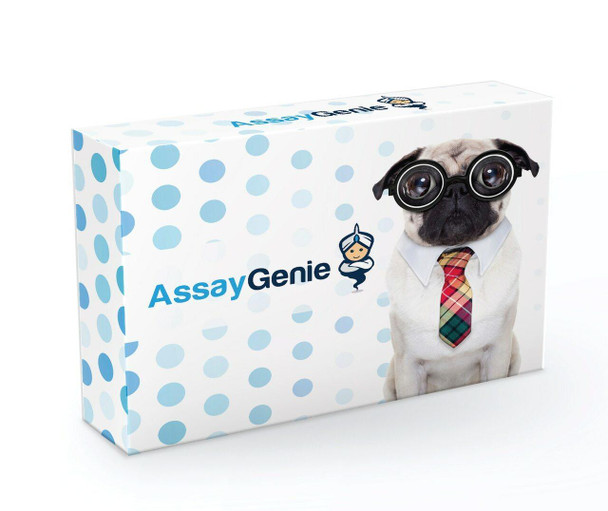Anti-AscL1 Antibody (CAB10669)
- SKU:
- CAB10669
- Product type:
- Antibody
- Reactivity:
- Human
- Host Species:
- Rabbit
- Isotype:
- IgG
- Antibody Type:
- Polyclonal Antibody
Description
| Antibody Name: | Anti-AscL1 Antibody |
| Antibody SKU: | CAB10669 |
| Antibody Size: | 20uL, 50uL, 100uL |
| Application: | WB |
| Reactivity: | Human |
| Host Species: | Rabbit |
| Immunogen: | Recombinant fusion protein containing a sequence corresponding to amino acids 77-236 of human AscL1 (NP_004307.2). |
| Application: | WB |
| Recommended Dilution: | WB 1:500 - 1:2000 |
| Reactivity: | Human |
| Positive Samples: |
| Immunogen: | Recombinant fusion protein containing a sequence corresponding to amino acids 77-236 of human AscL1 (NP_004307.2). |
| Purification Method: | Affinity purification |
| Storage Buffer: | Store at -20°C. Avoid freeze / thaw cycles. Buffer: PBS with 0.02% sodium azide, 50% glycerol, pH7.3. |
| Isotype: | IgG |
| Sequence: | GGHK SAPK QVKR QRSS SPEL MRCK RRLN FSGF GYSL PQQQ PAAV ARRN ERER NRVK LVNL GFAT LREH VPNG AANK KMSK VETL RSAV EYIR ALQQ LLDE HDAV SAAF QAGV LSPT ISPN YSND LNSM AGSP VSSY SSDE GSYD PLSP EEQE LLDF TNWF |
| Gene ID: | 429 |
| Uniprot: | P50553 |
| Cellular Location: | Nucleus |
| Calculated MW: | 25kDa |
| Observed MW: | Refer to figures |
| Synonyms: | ASCL1, ASH1, HASH1, MASH1, bHLHa46, AscL1 |
| Background: | This gene encodes a member of the basic helix-loop-helix (BHLH) family of transcription factors. The protein activates transcription by binding to the E box (5'-CANNTG-3'). Dimerization with other BHLH proteins is required for efficient DNA binding. This protein plays a role in the neuronal commitment and differentiation and in the generation of olfactory and autonomic neurons. Mutations in this gene may contribute to the congenital central hypoventilation syndrome (CCHS) phenotype in rare cases. |
| UniProt Protein Function: | ASCL1: Transcriptional regulator. May play a role at early stages of development of specific neural lineages in most regions of the CNS, and of several lineages in the PNS. Essential for the generation of olfactory and autonomic neurons. Involved in the initiation of neuronal differentiation. Mediates transcription activation by binding to the E box (5'-CANNTG-3'). |
| UniProt Protein Details: | Protein type:DNA-binding; Transcription factor Chromosomal Location of Human Ortholog: 12q23.2 Cellular Component: cell soma; nucleus Molecular Function:protein binding; protein homodimerization activity; DNA binding; double-stranded DNA binding; bHLH transcription factor binding; chromatin binding; transcription factor activity Biological Process: vestibular nucleus development; musculoskeletal movement, spinal reflex action; response to lithium ion; regulation of mitotic cell cycle; cell maturation; olfactory pit development; neuron migration; neuroblast fate determination; negative regulation of transcription from RNA polymerase II promoter; sympathetic nervous system development; response to folic acid; positive regulation of neuron apoptosis; neuron fate specification; oligodendrocyte development; positive regulation of Notch signaling pathway; central nervous system neuron development; Notch signaling pathway; response to retinoic acid; transcription, DNA-dependent; spinal cord oligodendrocyte cell fate specification; regulation of timing of subpallium neuron differentiation; positive regulation of cell cycle; cerebral cortex GABAergic interneuron differentiation; negative regulation of neuron differentiation; neurogenesis; subpallium neuron fate commitment; commitment of a neuronal cell to a specific type of neuron in the forebrain; regulation of gene expression; neuroblast proliferation; regulation of epithelial cell differentiation; spinal cord association neuron differentiation; positive regulation of transcription from RNA polymerase II promoter; cerebral cortex development; positive regulation of neuron differentiation; negative regulation of transcription, DNA-dependent; negative regulation of apoptosis Disease: Central Hypoventilation Syndrome, Congenital |
| NCBI Summary: | This gene encodes a member of the basic helix-loop-helix (BHLH) family of transcription factors. The protein activates transcription by binding to the E box (5'-CANNTG-3'). Dimerization with other BHLH proteins is required for efficient DNA binding. This protein plays a role in the neuronal commitment and differentiation and in the generation of olfactory and autonomic neurons. Mutations in this gene may contribute to the congenital central hypoventilation syndrome (CCHS) phenotype in rare cases. [provided by RefSeq, Jul 2008] |
| UniProt Code: | P50553 |
| NCBI GenInfo Identifier: | 55743094 |
| NCBI Gene ID: | 429 |
| NCBI Accession: | NP_004307.2 |
| UniProt Secondary Accession: | P50553,Q9BQ30, A8K3C4, |
| UniProt Related Accession: | P50553 |
| Molecular Weight: | 25,454 Da |
| NCBI Full Name: | achaete-scute homolog 1 |
| NCBI Synonym Full Names: | achaete-scute family bHLH transcription factor 1 |
| NCBI Official Symbol: | ASCL1 |
| NCBI Official Synonym Symbols: | ASH1; HASH1; MASH1; bHLHa46 |
| NCBI Protein Information: | achaete-scute homolog 1; ASH-1; achaete scute protein; achaete-scute complex-like 1; achaete-scute complex homolog 1; class A basic helix-loop-helix protein 46 |
| UniProt Protein Name: | Achaete-scute homolog 1 |
| UniProt Synonym Protein Names: | Class A basic helix-loop-helix protein 46; bHLHa46 |
| Protein Family: | Achaete-scute |
| UniProt Gene Name: | ASCL1 |
| UniProt Entry Name: | ASCL1_HUMAN |





